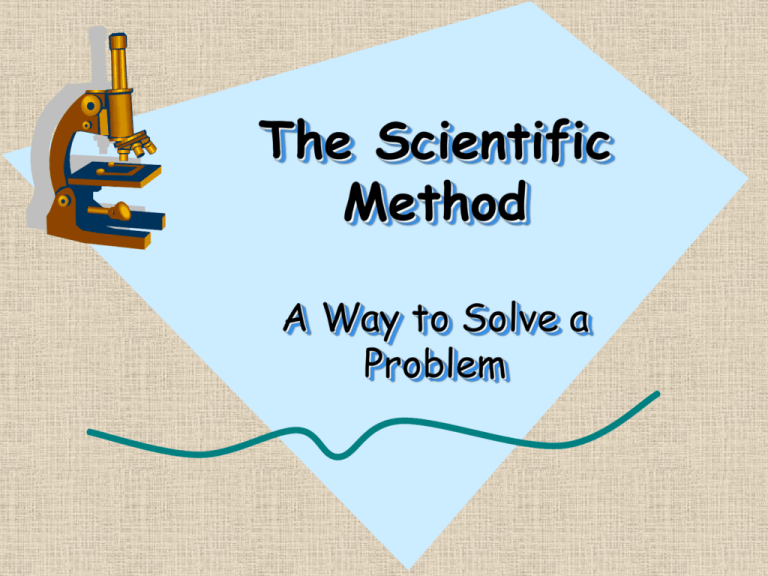The Scientific Method *A Way to Solve a Problem*
advertisement

The Scientific Method A Way to Solve a Problem What is the Scientific Method? • It is the steps someone takes to identify a question, develop a hypothesis, design and carry out steps or procedures to test the hypothesis, and document observations and findings to share with someone else. TYPES OF OBSERVATIONS Quantitative- involves numbers Gravity- 9.8m/sec/sec Qualitative- physical or chemical qualities Observations lead to the development of a question. Hmmm…do ALL objects fall at this rate? The question leads one to… gather information (you find out that gravity is dependent on mass of the object and the distance that separates the two) and form a hypothesis (IF objects have a lot of mass, THEN they should fall faster) The next step scientists take is to create and conduct an experiment to test their hypothesis. ( Bowling ball vs. marble drop) Controls- height, methodology Independent variable- what the experimenter manipulates (changes)… (mass of objects) Dependent variable-What the experimenter is measuring (Time it takes to reach ground) RESULTS, ANALYSIS, and CONCLUSION: • Finally you gather information based on your experiment, analyze the data to determine what your experiment showed you about the phenomena you questioned, and come up with a conclusion based on it. Was your hypothesis correct? Incorrect? Why? What other questions does it leave you with? (You happen to find that both objects hit the ground at the same time! Why????)…a lesson in perspective. The Earth was way compared to either bowling ball or marble…it didn’t produce enough change to measure. The steps of the Scientific Method are: • Observations lead to Questions • Background Research-what do we already know • Hypothesis- what do we expect will occur • Conduct ExperimentProcedures/Method • Collect and Analyze Results/Table/stats/graphs • Conclusion PERSPECTIVE CHANGES EVERYTHING • IS SCIENCE OBJECTIVE OR SUBJECTIVE??? A lesson in perspective: What we see is dependent on our gaze A lesson in perspective: What we see is dependent on our frame of mind What we see is dependent on… Angle WHAT WE SEE IS DEPENDENT • …ON HOW CLOSE WE LOOK… - BIG WORLD PPT. CONCLUSIONS ARE NEVER OBJECTIVE…ALWAYS SUBJECTIVE Scientific Theories and Laws • Scientific theory- explanation that has been tested by repeated experiments Theories must explain observations simply and clearly (theory that heat is the energy of particles in motion explains how the far end of a metal tube gets hot when placed in an open flame) Experiments must illustrate theory is repeatable ( the far end of the tube ALWAYS gets hot regardless of how many times it is done) You must be able to make predictions based on it. ( you might predict that anything that makes particles move faster will make the object hotter. Sawing a piece of wood will make the particles move faster, and will make it hotter as well.) Scientific law states a repeated observation of nature but doesn’t explain why warm objects become cooler. Math and models • Equations describes relationships between quantitative measurements • It is a universal language. Universal law of gravitation MODELS • Represent things that are either too large, small, or complex to study easily. Also to as a mental picture to predict what will happen (eg. Chemical equations) • Computer models-often mathematical models that can save time and $$ because calculations are done by machines (eg. Crash test for motion/forces to improve car design) SI units: The International System of Units • WHY SI??? To be on the same page…comparing apples to apples (meters to meters, liters to liters) Units are just like numbers…they can be multiplied, divided, and reduced! • SI prefixes are for very large or very small measurements…instead of expressing that you traveled 800,000 m in distance, you would use 800 km to avoid using several zeros. • SI prefixes are in multiples of 10. • This makes it easy to convert SI units into larger or smaller units by moving the decimal. Conversions • If a person’s height is 1.85 m, how many cm is this person? • 1.85 m x 100 cm = 185 cm ------------m DOES THIS MAKE SENSE???







